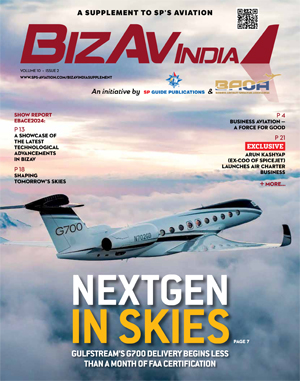Sustainable Alternative Jet Fuels
Alternative fuels would reduce global warming, facilitate energy independence and soften the economic uncertainties of peaking crude oil prices, while simultaneously providing attractive benefits in carbon trading.

A Media update of August 27, 2018, announced the ‘first flight’ by a SpiceJet Q400 aircraft from Delhi to Dehradun using 330 kg of “Biojet fuel” made by CSIR–IIP, Dehradun and used in a 25:75 ratio with standard aviation fuel to power the approximately 45-minute flight. The biofuel produced has reportedly been recognised by the American Standard Testing Method (ASTM) and has met the specification standards of the engine manufacturer Pratt & Whitney and the aircraft manufacturer Bombardier, as being acceptable for commercial application in aircraft.
The occasion led to declarations of enhancing manufacturing capacities, and the initiation of “special policies” for the production and the use of biofuels in the aviation sector. An earlier Biofuel policy in 2009 had focused on transportation in general, but not specifically on aviation, presumably due to the sector’s low contribution to overall national Greenhouse Gas (GHG) emissions. In the absence of any significant General or Business Aviation activity in the country, the focus is on ‘domestic’ aviation, most of which is commercial airline. But the Minitsry of Civil Aviation is yet to put up any proposal to operate regular flights with a blend of bio jet fuel and Aviation Turbine Fuel (ATF). A study of the efforts and processes involved in the development, production and usage of sustainable fuel alternatives would enable understanding just how far we need to go if our aspirations and proclamations are to translate into reality.
THE SUSTAINABLE ALTERNATIVE JET FUEL (SAJF) INITIATIVE
The SAJF initiative was developed by a coalition of international aviation organisations. The initiative was designed:
- To address a perceived “knowledge gap” on the availability and safety of SAJF.
- To encourage the spread of the use alternative jet fuels among manufacturers, ground handlers and operators, at the regional, national and international levels.
Goals set in 2009 were: - Two per cent improvement in fuel efficiency per year from 2010 to 2020;
- Carbon-neutral growth from 2020 onwards; and,
- Reduction in CO2 emissions of 50 per cent by 2050, relative to 2005.
On May 28, 2018, while reaffirming its focus on the development and adoption of SAJF, it was postulated that:
- SAJF for business aviation is safe, tested, approved and available today, though in limited quantities. Redesign of engines or aircraft will not be necessary. The fuels can simply be used whenever they are available.
- SAJF offers many benefits:
- They support compliance with emerging international emissions standards of ICAO and the EU.
- Their use allows facilitates the achievement of corporate social responsibility goals and demonstrates industry commitment to addressing climate change.
- Alternative fuels may provide improved efficiency, reducing operating costs and extending flight-range capabilities.
- SAJF can be produced from multiple, sustainable feedstock, and there is significant reduction in carbon emissions, when compared emissions from fossil-derived fuels.
TECHNOLOGY STATUS, COST ESTIMATES AND POLICY IMPERATIVES
Technology. The aviation sector emits two to three per cent of the human-induced total of GHG. For significant long-term reduction of emissions ‘Bio-jet’ or ‘Bio-jet fuels’ is the only option presently available. They require an additional processing step to address fuelfreezing issues and hence push up production costs. Other sustainable and clean alternative propulsion technologies in development are unlikely to be ready for commercial use until well after 2050. But current indicators are that these may compel extensive modifications to aircraft and engine designs.
Bio-jet offerings must be readily available fuels, functionally equivalent to jet fuel with its performance equal to or better than fossil-derived jet fuels
Performance. Bio-jet offerings must be readily available fuels, functionally equivalent to jet fuel (IEA Bio-energy, 2014) with its performance equal to or better than fossil-derived jet fuels. Current ASTM-certified bio-jet fuels can be used in blends of up to 50 per cent with fossil-derived jet fuel, depending on the type. Because synthetic jet fuel and bio-jet fuel have approximately the same weight, volume and performance characteristics of current oil-derived jet fuel, they would be relatively easy to use and would not affect the design of the airplane or engines (NASA 2006 Report).
Certification. Certification is required before commercial airlines or other users can use a fuel for flight. Hydro-processed Esters and Fatty Acids (HEFA bio-jet), using feedstock such as oil and fats is the base technology that was ASTM–certified in 2011. The development and deployment of primarily HEFA bio-jet has encompassed equipment manufacturers, airlines, fuel producers and airports. Certification of other, more advanced bio-jet conversion-technology pathways through ASTM can take years and would include rigorous fuel testing and evaluation. The process can be very costly and timeconsuming, typically, three to five years and will cost around $10 to $15 million. Driving down costs and reducing the time required for certification is vital.
Production Initiatives. The US and the EU have made considerable progress in enhancing the use of aviation bio-jet fuels. Many airports and manufacturers have guaranteed maintenance of the supply lines through standard distribution channels on a “drop-in” basis. Airlines and other operators have agreed to uptake the fuels offered. Alternative fuels for aviation have significantly changed over the last four years. More technologies have been accepted by aviation fuel standards, but the volume available is extremely limited and cost disparity with fossil fuels is larger than expected. The ‘Initiative Towards Sustainable Kerosene for Aviation (ITAKA)’ consortium has demonstrated the use of the bio-jet blend in conventional airport fuel storage and handling systems. This logistics mode is economically advisable, feasible and fully compliant with airport operations and user requirements. Since the end of 2015, all flights departing from Oslo airport are using bio-jet fuel. This would amount to about 60,000 flights and about six million passengers. This operation has demonstrated that claims for the use of bio-jet fuel in the Emissions Trading System (ETS) could be applied internationally across Member States and could reduce the current price gap between the conventional and bio-jet fuels. The consortium has concluded however, that even at this small scale, the availability of sustainable European feedstock is a clear bottleneck. New crops require a long time to expand and to become significant.
Commitment. The integration and organisation of the whole aviation bio-fuel value-chain must be optimised to reduce fuel cost. An IEA Energy Analysis of March 22, 2019 notes that since the first flight using blended bio-fuel in 2008 and although more than 150,000 flights have used bio-fuels since then, only five airports have regular bio-fuel distribution (Bergen, Brisbane, Los Angeles, Oslo and Stockholm), with others offering occasional supply. Since less than five per cent of all airports handle 90 per cent of international flights, SAF availability at a few airports could cover a large share of demand. Long-term off take agreements between airlines, bio-fuel producers and airport suppliers cumulatively, cover around six billion litres of fuel. The demand has led some airlines to directly invest in aviation bio-fuel refinery projects. Still, aviation bio-fuel production of about 15 million litres in 2018 accounted for less than 0.1 per cent of total aviation fuel consumption. More rapid market development and delivery are required to meet pre-agreed emission reduction targets.

Cost of Production. Fuel accounts for about 30 per cent of the total expense of operating an airline. Potential feed stocks for HEFA-bio-jet alone often cost more than traditional jet fuel and costs fluctuate considerably. These variations are highly dependent on production process, plant scale, and performance. Conversion into HEFA-bio-jet adds to the price gap. Bio-jet is significantly more expensive – from two to seven times more than fossil derived jet fuel (IATA, 2015). The quantum of definitive reductions in GHG emissions is not likely to meet desired limits soon.
Resource Availability. The availability of feedstock is one of the main cost drivers and one of the most significant hurdles to be overcome in scaling up of production. Currently, the bulk of bio-jet fuel is produced from used cooking oil, animal fats, and vegetable oils (e.g. camelina and canola), via the HEFA pathway. This feedstock has limited availability. As of January 2017, five production pathways have been certified by the ASTM process. But many of these processes require additional feedstock to be developed for conversion to AJF.
Many challenges remain to develop solutions that will provide readily available, affordable and sustainable alternative fuels to air operators
Policy Imperatives. The process to create bio-jet fuels is also the same as for bio-diesel products. Since bio-diesel users significantly outnumber bio-jet fuel users, manufacturers have traditionally relegated the latter to the backburner. Bio-diesels provide quicker and greater returns due to a larger market and higher sales prices. Even if all the available bio-fuel production capacities were to be used to make bio-jet, supply would still amount to less than 1.5 per cent of the world’s jet fuel requirements. ICAO has reached an agreement on a Global Market-Based Measure (GMBM) scheme to reduce aviation-derived carbon emissions through offsetting. Implementation will not begin until 2021. Only a few countries have established policies to encourage bio-jet fuel production. However, there are no bio-jet-specific policies to encourage commercialisation of the entire supply chain. Although carbon offsets will encourage global emissions reductions, they alone will not drive bio-jet development. Specific policies are crucial, at national and international levels to incentivise and to encourage biojet production and consumption.
CONCLUSION
Seamless transition to alternative fuels requires R&D. Alternative fuels would reduce global warming, facilitate energy independence and soften the economic uncertainties of peaking crude oil prices, while simultaneously providing attractive benefits in carbon trading. Domestic and global trends in energy security and corporate responsibility have encouraged many public and private sector organisations to commit to adopting alternative aviation fuels. Off take agreements between bio refineries and airlines have attracted significant investment and the numerous stakeholder organisations that have formed around alternate fuels, illustrate the long-term growth potential.
It would not be possible to grow enough bio-feedstock (crops) to replace significant volumes of crude oil production. Efficient utilisation of available agricultural lands demands careful consideration for crop selection, the method of fuel processing and the type of bio-fuel to be produced. Many challenges remain to develop solutions that will provide readily available, affordable and sustainable alternative fuels to air operators. Like the First-Generation bio-fuels, Alternative Jet Fuel is a bio-fuel of the future, whose time has not quite arrived, but which is surely en route and ‘just around’ the proverbial corner.





